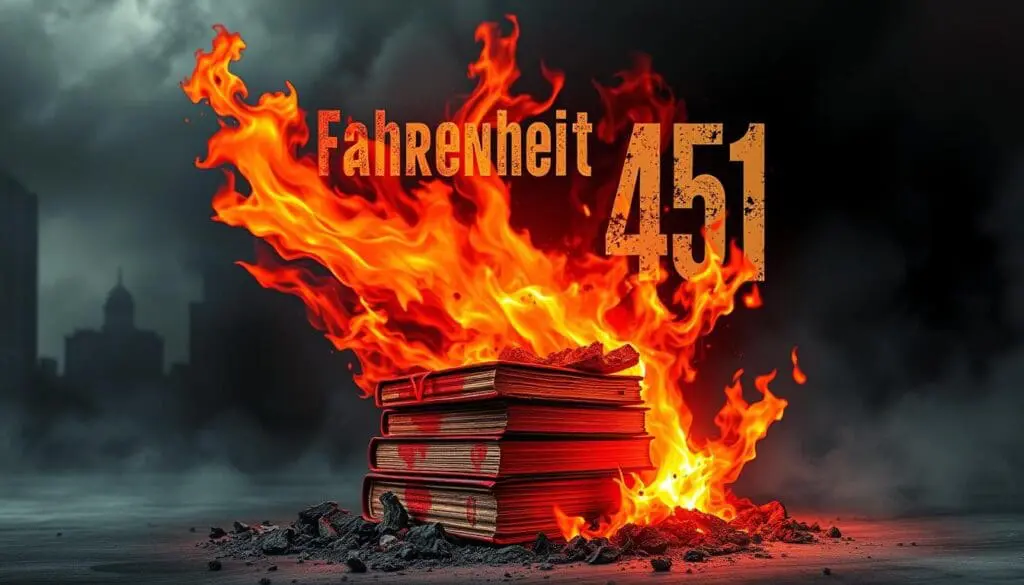Contents
Introduction
Ray Bradbury’s Fahrenheit 451 grabs readers with a shocking concept: firemen who burn books instead of saving them. Published in 1953 during the Cold War, this dystopian novel presents a world where Guy Montag is a fireman tasked with burning books, along with the houses that conceal them. The title refers to the temperature at which book paper catches fire and burns, creating a haunting image that leaves a lasting impact on the readers long after they finish the story.

A World Where Knowledge Burns
Fahrenheit 451 is set in an unspecified city where society has chosen comfort over curiosity. In this world, books are banned, and people spend their time watching television on wall-sized screens instead of reading. The story follows Guy Montag, who begins his journey believing “it was a pleasure to burn.” However, his perspective changes when he meets his new neighbor, a girl named Clarisse McClellan, whose free-thinking ideals and liberating spirit cause him to question his life and everything he thought he knew.

Bradbury envisioned a world that might evolve over the next four or five decades, and his predictions feel surprisingly accurate today. The author thought he was describing a world where technology and instant entertainment would replace deep thinking and genuine human connection. Half a century later, many readers find his warnings unnervingly relevant.
Characters That Shape the Story
The novel by Ray Bradbury introduces several memorable characters who represent different aspects of society. Guy Montag starts as a loyal fireman but gradually develops an interest in reading after meeting Clarisse. She represents curiosity and independent thinking in a world that fears both. Unfortunately, Clarisse is later killed by a speeding car, symbolizing how society destroys those who think differently.
Captain Beatty, the fire chief, serves as the story’s main antagonist. He’s well-educated and understands the power of literature, but he chooses to suppress it. Beatty uses logic and knowledge to justify censorship, making him a particularly troubling character.
Mildred, Montag’s wife, represents people who have fallen asleep in the afternoon sunshine of entertainment. She and her friends watch television constantly and numb themselves with sleeping pills when reality becomes too uncomfortable. Mildred refuses to leave her comfortable but empty life, even when it becomes dangerous.

An English professor named Faber helps Montag understand why books matter. He explains that books contain great works of human thought and creativity. When interest groups and government forces Montag to burn these treasures, Faber encourages him to memorize important texts to preserve them.
Themes That Still Matter Today
Bradbury’s Fahrenheit 451 explores how censorship can emerge not just from government control but from public indifference. The story illustrates how television undermines interest in reading literature, replacing in-depth thought with superficial entertainment. People stop reading before books are officially banned, choosing instant gratification over challenging ideas.
The mechanical hound represents technology used for control rather than progress. This robotic creature hunts down anyone who dares to read any of the books, creating fear that keeps people obedient. The hound symbolizes how even helpful technology can become dangerous when used by those who want to control others.

Fire appears throughout the story as both a destructive and creative force. While firemen use flamethrowers to destroy knowledge, fire also represents the potential for renewal and change. The novel suggests that society can rise from its ashes if people choose to value knowledge and human connection again.
Strengths and Weaknesses
Ray Bradbury’s writing style combines vivid imagery with urgent pacing. The short novel Fahrenheit 451 reads like a book of poetry at times, with beautiful language that brings the dystopian world to life. The opening line immediately draws readers in, and the story maintains its energy throughout.
However, some critics find the book’s brevity works against it. Character development beyond Montag feels limited, and certain plot points happen too quickly. The pacing sometimes rushes through important emotional moments that could benefit from more exploration.
The novel works best as a cautionary tale rather than a perfectly crafted story. While it may not achieve the literary depth of other dystopian classics, its central message about intellectual freedom gives it lasting importance.
Adaptations and Cultural Impact
The 1966 film adaptation directed by François Truffaut brought Bradbury’s vision to the screen, though it simplified some of the book’s themes. More recent adaptations, including audiobook versions and television productions, continue to find new audiences for this classic work.

Students who read Fahrenheit 451 often find connections to modern concerns about social media, shortened attention spans, and the decline of deep reading. The book’s exploration of how entertainment can replace genuine experience speaks to contemporary debates about technology’s role in society.
A Mixed but Important Legacy
Critics generally view Ray Bradbury’s Fahrenheit 451 as an important work that succeeds more as a philosophical warning than as pure entertainment. The novel raises crucial questions about technology, education, and human nature that remain relevant today.
While writing the short novel Fahrenheit 451, Bradbury created a world that feels both fantastical and frighteningly possible. His vision of a society where books are burned and free thinking is discouraged serves as a powerful reminder of the fragility of knowledge.
The story of an old woman who refuses to leave her burning house because she’d rather die with her books than live without them creates one of literature’s most powerful images of resistance. When Montag is forced to burn the house, readers witness both the destruction of knowledge and the birth of a rebel.
For readers seeking an introduction to dystopian literature, this book provides valuable insights while remaining accessible. The novel’s flaws don’t diminish its importance as a cultural touchstone. Bradbury’s vision may be imperfect, but it effectively warns against the dangers of choosing comfort over curiosity.
The temperature at which paper burns becomes more than just a scientific fact—it represents the fragility of human knowledge and the constant threat to intellectual freedom. In a society where books are seen as dangerous and people prefer to remain asleep in the afternoon sunshine of entertainment, Fahrenheit 451 reminds us that the price of freedom is eternal vigilance.

Whether readers discover the story through a copy of the book, an audiobook, or even references in other works like the Book of Ecclesiastes, Bradbury’s message remains clear: knowledge and free thinking are precious gifts that require active protection. The novel continues to spark important conversations about censorship, technology, and human nature, proving its enduring relevance in our rapidly changing world.
My Rating:- ★ ★ ★ ★ ★
Goodreads Rating: 3.97
Fahrenheit 451 by Ray Bradbury Reviewed On:
- e-book
- Total pages: 243
- Genre: Science Fiction
- Fahrenheit 451 by Ray Bradbury








Imagine if firemen actually started burning Kindles instead of books. That’s some next level Fahrenheit 451 for ya.
That’s a fun thought! The battle might one day shift from paper to digital.
Interesting analysis. Do you believe Bradbury was more concerned about censorship or the decline in reading habits? And how do you see this reflecting in our education system today?
I think it’s about how society’s getting dumber ’cause we dont read. my school doesn’t even care if we read proper books anymore.
You’ve got a point—reading is our way to stay sharp. Schools should encourage it more.
Nah, it’s definitely about the control of information. Like, how tech can be used to monitor and control us. Reading’s just part of that.
Absolutely, tech is a double-edged sword. Knowledge and control both grow with it.
I think Bradbury warned us about both. Today’s schools show we need to protect real reading.
Totally loved your take on Fahrenheit 451, Vishal. It’s incredible how Bradbury’s themes are still so relevant. Got me thinking about how much we prioritize screens over books even today. Brilliant analysis!
Right? It’s like we’re living in a mild version of that dystopia. Crazy how art predicts life sometimes.
Really true, Rick. Sometimes fiction feels like a sneak peek at reality.
Thanks so much! Bradbury’s message is even more important in our screen-filled world.